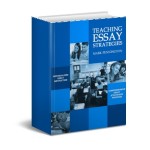The Parts of an Essay
To be able to teach our students how to write effective essays, we first have to identify the underlying problem.
I think we are the problem. We confuse students. We don’t mean to do so, but we do. The problem is compounded by the fact that students are exposed to many different teachers, each with a different knowledge base, a different set of teaching experiences, and a different language of instruction.
This article will pose questions and only hint at a possible solution. If all your questions about essay terminology have been answered, read no further.
The Parts of an Essay
……
Let’s begin with the thesis statement. We all have different expectations as to what is and what is not a thesis statement. The Common Core writers compound the problem by using confusing terminology and reducing all exposition to Writing Standards 1 and 2.
To pose a few questions: Is a thesis the same as a claim? or include a claim? Does a thesis apply to both argumentative and informational writing? Is a thesis the main idea/purpose of the writing? Does a thesis always state a point of view? Is a literary thesis different than one in science, or one in the humanities, or one in social science/history? Can a thesis pose a question to be explored? Does the thesis always have to be arguable? Does a thesis statement have to be placed in an introductory paragraph? Does a thesis statement have to be placed last in the introduction? Does a thesis statement have to include the topics/claims/main points of each of the body paragraphs? Is a split (divided) thesis permissible? How general or how specific should a thesis statement be? Should a thesis statement use as many of the words from the writing prompt as possible? Is it realistic/possible to apply a generic definition for a thesis statement to all genre/domains of exposition? For example, a pro-con, cause-effect, compare-contrast, personal essay?
Then to muddy the water a bit: What is the purpose of the introductory paragraph(s) with respect to the thesis statement? Do non-narrative essays have “hooks?” Must introductions be ordered from general to specific (a.k.a. funnel paragraphs)? Are rhetorical questions permissible? Is background/context/a brief summary required? Are there different introduction strategies for different genre/domains of writing?
Then… to muddy the water even more: What about the purpose and terminology of body paragraphs? Is it a topic/ or topic sentence, claim, or reason? Does evidence always precede analysis? Is a concluding statement ever/always included? Are counterclaims and refutations best included as separate body paragraphs or as embedded within body paragraphs. Is a variety of evidence preferred? Are direct quotes preferred over indirect quotes when textual evidence is cited? When is textual evidence needed and when is it not?
Of course this leads to conclusions. The Common Core writers seem to discount conclusions. Are concluding paragraphs necessary? Is a thesis restatement necessary in a brief five paragraph essay? Does a conclusion always include a summary? Does a conclusion always include a “call to action?” What is the purpose of a conclusion? What does “give a finished feel to the essay” mean?
We all know that “cookie-cutter” approaches to complex tasks, e.g. writing, are rarely effective; however, I’m still interested in them. Some are clearly more useful than others.
The most useful set of terminologies I’ve found to be effective with students is a numerical hierarchy. An argumentative or informational explanatory essay might look like the following:
Introduction
(1) (1) (2)
Body Paragraphs
(3) (4) (5) (5) (4) (5) (5) – (4) (5) (5) (4) (5) (5) (3) – (4) (5) (3) (4) (5) (5) (5)
Conclusion
(2) (6) (6)
*****
The author’s TEACHING ESSAYS BUNDLE includes the three printable and digital resources students need to master the CCSS W.1 argumentative and W.2 informational/explanatory essays. Each no-prep resource allows students to work at their own paces via mastery learning. How to Teach Essays includes 42 skill-based essay strategy worksheets (fillable PDFs and 62 Google slides), beginning with simple 3-word paragraphs and proceeding step-by-step to complex multi-paragraph essays. One skill builds upon another. The Essay Skills Worksheets include 97 worksheets (printables and 97 Google slides) to help teachers differentiate writing instruction with both remedial and advanced writing skills. The Eight Writing Process Essays (printables and 170 Google slides) each feature an on-demand diagnostic essay assessment, writing prompt with connected reading, brainstorming, graphic organizer, response, revision, and editing activities. Plus, each essay includes a detailed analytical (not holistic) rubric for assessment-based learning.


